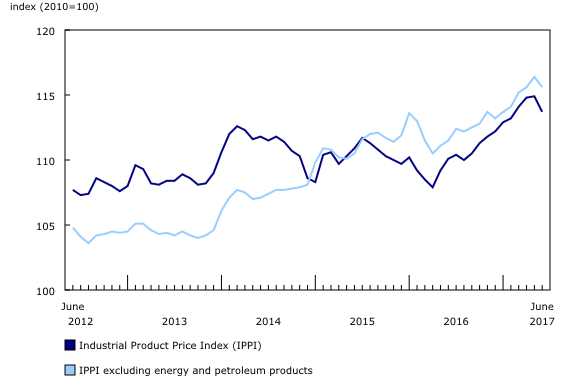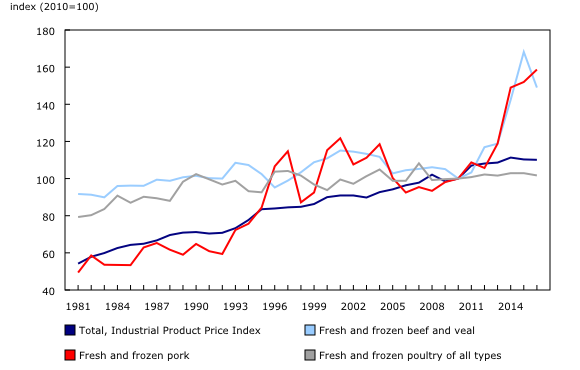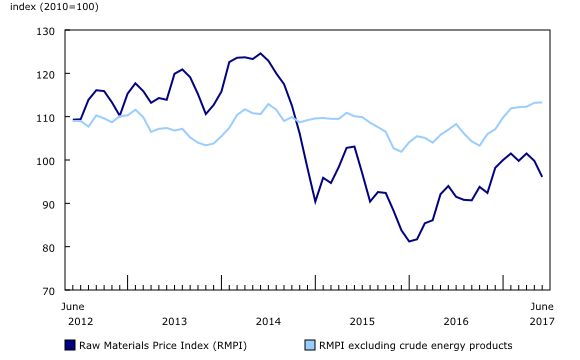Industrial product and raw materials price indexes, June 2017
Archived Content
Information identified as archived is provided for reference, research or recordkeeping purposes. It is not subject to the Government of Canada Web Standards and has not been altered or updated since it was archived. Please "contact us" to request a format other than those available.
Released: 2017-07-31
The Industrial Product Price Index (IPPI) declined 1.0% in June, mainly due to lower prices for energy and petroleum products. The Raw Materials Price Index (RMPI) declined 3.7%, primarily due to lower prices for crude energy products.
Industrial Product Price Index, monthly change
The IPPI fell 1.0% in June, after edging up 0.1% in the previous month. Of the 21 major commodity groups, 16 were down and 5 were up.
The decrease in the IPPI was mainly due to lower prices for energy and petroleum products (-4.1%), which experienced their largest decline since February 2016. The decline in this product group was mainly due to lower prices for motor gasoline (-4.0%), diesel fuel (-6.1%) and light fuel oil (-5.6%). The IPPI excluding energy and petroleum products was down 0.7%.
Motorized and recreational vehicles (-1.5%) also contributed significantly to the decline in the IPPI in June. Lower prices for passenger cars and light trucks (-1.6%) and, to a lesser extent, motor vehicle engines and motor vehicle parts (-1.1%) and aircraft (-2.1%) were the main contributors to the decline in this product group. Lower prices for motorized and recreational vehicles were closely linked to the appreciation of the Canadian dollar relative to the US dollar.
Primary non-ferrous metal products (-2.2%) were down for a second consecutive month in June, mainly due to lower prices for unwrought precious metals and precious metal alloys (-2.1%), unwrought aluminum and aluminum alloys (-4.5%), as well as other unwrought non-ferrous metals and non-ferrous metal alloys (-4.1%).
Prices for chemical products (-1.6%) posted their largest decline since February 2016. This decrease was mainly attributable to lower prices for petrochemicals (-6.9%) and, to a lesser extent, plastic resins (-1.8%).
Conversely, the decline in the IPPI was primarily moderated by the meat, fish and dairy products group (+1.7%), which posted a sixth consecutive monthly increase. This increase was mainly due to higher prices for fresh and frozen pork (+9.2%), while prices for fresh and frozen beef and veal decreased 1.5%.
Some IPPI prices are reported in US dollars and converted to Canadian dollars using the average monthly exchange rate. Consequently, any change in the value of the Canadian dollar relative to the US dollar will affect the level of the index. From May to June, the Canadian dollar appreciated 2.3% relative to the US dollar. If the exchange rate had remained constant, the IPPI would have decreased 0.5% instead of 1.0%.
Industrial Product Price Index, 12-month change
The IPPI rose 3.3% over the 12-month period ending in June, after posting a 5.2% increase in May.
Primary non-ferrous metal products (+9.9%) were the largest contributor to the year-over-year growth in the IPPI. Higher prices for other unwrought non-ferrous metals and non-ferrous metal alloys (+26.8%), unwrought copper and copper alloys (+26.8%), as well as unwrought aluminum and aluminum alloys (+15.4%) were mainly responsible for the increase in this product group.
Prices for chemical products (+5.8%), particularly petrochemicals (+13.3%), ammonia and chemical fertilizers (+20.8%), and chemicals not elsewhere classified (+8.2%) also contributed significantly to the year-over-year increase in the IPPI.
Prices for meat, fish and dairy products (+4.7%) and motorized and recreational vehicles (+2.1%) also contributed to the year-over-year growth in the IPPI.
Prices for fresh and frozen pork (+9.2%) and fresh and frozen beef and veal (+7.4%) were the main contributors to the year-over-year rise in the meat, fish and fish products group. Prices for motor vehicle engines and motor vehicle parts (+2.9%), passenger cars and light trucks (+1.5%) and aircraft (+4.4%) were the main contributors to the increase in motorized and recreational vehicles.

In celebration of the country's 150th birthday, Statistics Canada is presenting snapshots from our rich statistical history.
The Industrial Product Price Index (IPPI) tracks the factory gate prices of the meat that goes on your grill. From January 1981 to June 2017, the total IPPI increased 118%, while the price of fresh and frozen pork increased 304%, the price of fresh and frozen beef and veal increased 69%, and the price of fresh and frozen poultry of all types increased 38%.
Over the past five years, prices for chicken products have remained relatively stable while the growth in pork and beef product prices has been especially strong. Since January 2011, partly due to supply challenges caused by droughts and animal diseases, the price of pork products increased 87% and the price of beef products increased 59%. By comparison, the total IPPI increased 10% during the same period.
Raw Materials Price Index, monthly change
The RMPI fell 3.7% in June. This was the second consecutive monthly decline and the largest decline since December 2015. Of the six major commodity groups, four were down, one was up and one was unchanged.
The decrease in the RMPI was primarily due to lower prices for crude energy products (-9.3%), particularly conventional crude oil (-9.6%). This was the largest decline in crude energy products since January 2016, when prices fell 11.7%. The RMPI excluding crude energy products edged up 0.1%.
To a lesser extent, prices for metal ores, concentrates and scrap (-0.9%) also contributed to the decline in the RMPI.
The decline in the RMPI was moderated by higher prices for animals and animal products (+1.8%), led by prices for live animals (+2.7%), particularly hogs (+11.3%). Lower prices for cattle and calves (-2.1%) moderated the increase in the animals and animal products group.
Raw Materials Price Index, 12-month change
The RMPI increased 2.2% in the 12-month period ending in June, after posting a 8.4% increase in May.
The gain in the RMPI compared with June 2016 was mainly attributable to higher prices for metal ores, concentrates and scrap (+12.7%), which have been increasing year-over-year since July 2016.
Animals and animal products (+5.2%) also contributed to the year-over-year increase in the RMPI. Higher prices for live animals (+5.1%), particularly cattle and calves (+9.6%), were the main contributors to the rise in this product group. Prices for fish, shellfish and other fishery products (+13.7%), as well as other animal products (+2.9%), also contributed to the growth in animals and animal products.
Year over year, the increase in the RMPI was primarily moderated by prices for crude energy products (-3.2%), particularly conventional crude oil (-3.6%). This was the first year-over-year decline in conventional crude oil since September 2016. The RMPI excluding crude energy products was up 5.9%.
Crop products (-3.5%) also declined compared with June 2016. Lower prices for oilseeds (excluding canola) (-15.2%), as well as other miscellaneous crop products (-7.8%) were the main contributors to the decline.
Note to readers
The Industrial Product Price Index (IPPI) and Raw Materials Price Index (RMPI) are available at the Canada level only. Selected commodity groups within the IPPI are also available by region.
With each release, data for the previous six months may have been revised. The indexes are not seasonally adjusted.
The Industrial Product Price Index reflects the prices that producers in Canada receive as the goods leave the plant gate. It does not reflect what the consumer pays. Unlike the Consumer Price Index, the IPPI excludes indirect taxes and all the costs that occur between the time a good leaves the plant and the time the final user takes possession of it, including transportation, wholesale and retail costs.
Canadian producers export many goods. They often indicate their prices in foreign currencies, especially in US dollars, which are then converted into Canadian dollars. In particular, this is the case for motor vehicles, pulp, paper and wood products. Therefore, a rise or fall in the value of the Canadian dollar against its US counterpart affects the IPPI. However, the conversion into Canadian dollars only reflects how respondents provide their prices. This is not a measure that takes the full effect of exchange rates into account.
The conversion of prices received in US dollars is based on the average monthly exchange rate established by the Bank of Canada and available in CANSIM table 176-0081 (series v111666275). Monthly and annual variations in the exchange rate, as described in the release, are calculated according to the indirect quotation of the exchange rate (for example, CAN$1 = US$X).
The Raw Materials Price Index reflects the prices paid by Canadian manufacturers for key raw materials. Many of those prices are set on the world market. However, as few prices are denominated in foreign currencies, their conversion into Canadian dollars has only a minor effect on the calculation of the RMPI.
A Historical Timeline of Canadian Producer Price Statistics
To celebrate Canada 150, A Historical Timeline of Canadian Producer Price Statistics, which is part of Statistics Canada — Infographics (11-627-M), was created to showcase the key milestones in the history of Canadian producer price statistics. This historical timeline contains answers to questions such as: Who collected Canada's first statistics? What do Canadian producer price indexes measure?
Infographic: Producer Price Indexes at a Glance
The infographic "Producer Price Indexes at a Glance," which is part of Statistics Canada — Infographics (11-627-M), demonstrates how producer price indexes for goods and services are calculated and why they are important for the Canadian economy.
Real-time CANSIM tables
Real-time CANSIM table 329-8074 will be updated on August 8. For more information, consult the document Real-time CANSIM tables.
Next release
The industrial product and raw materials price indexes for July will be released on August 29.
Contact information
For more information, or to enquire about the concepts, methods or data quality of this release, contact us (toll-free 1-800-263-1136; 514-283-8300; STATCAN.infostats-infostats.STATCAN@canada.ca) or Media Relations (613-951-4636; STATCAN.mediahotline-ligneinfomedias.STATCAN@canada.ca).
- Date modified:






